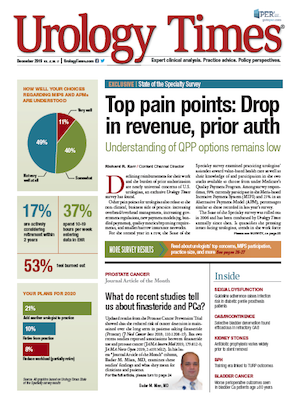Publication
Article
Urology Times Journal
2020 final rule reveals small gains for urology reimbursement
Author(s):
Urology will make a modest gain overall in the 2020 final rule for the Medicare Physician Fee Schedule, although the truly significant changes won’t be felt until 2021.
ipopba - stock.adobe.com


Ray Painter, MD

Mark Painter
Urology will make a modest gain overall in the 2020 final rule for the Medicare Physician Fee Schedule, although the truly significant changes won’t be felt until 2021.
The conversion factor update, as expected, is minimal for 2020; the conversion factor is set to increase to $36.09, up from $36.06. With changes in some practice expense values to some higher volume procedures, urology is projected to be up 1% overall.
MIPS and value-based programs
Medicare continues to make changes to both the alternative payment model program and Merit-based Incentive Payment System (MIPS) payment structure. Changes for 2020 for the MIPS program, under which the vast majority of urologists are measured, are focused on making the threshold to avoid penalties more difficult, increasing the number of providers who will potentially pay a penalty. Simultaneously, the rule changes the upper end of the program to attempt to decrease the number of physicians who will be awarded payments for high performance, which may increase the dollar amounts awarded to those that qualify. The combination is designed to increase participatory effort with both the carrot and the stick.
Also from the Painters - Cystoscopy plus patient discussion: Can –25 modifier be used?
A summary of these changes follows:
• minimum score of 45 for performance in 2020 (up from 30 for 2019)
• Quality category adjusted to 40%
• Cost category adjusted to 20%
• minimum score for exceptional performers will be raised to a minimum of 80 points
• maximum penalty for those failing to meet MIPS requirement increases to –9%, up from –7%
• penalties and bonuses will be applied to payments in 2022 based on 2020 reporting.
The rule also finalized a series of changes to go into effect in 2021 that will attempt to connect the four categories in a new “MIPS Value Pathways” proposal, which the AUA attempted to block. Changes to accountable care organizations were made as well but will not be covered in this article. We refer you to Robert Dowling, MD’s article (“How MIPS Cost category changes will affect urologists") and qpp.cms.gov for more detailed information on the Quality Payment Program.
Next: RVU winners and losersRVU winners and losers
The 1% increase in projected payments for urology is based on the conversion factor change, projected changes in volume, and the changes made to relative value units. The list of RVU percent changes in table 1 shows the effect of RVU changes for the facility setting. Note: Only codes that demonstrated a 5% or greater change are included in the table.
Video - Medicare final rule: Changes affect cysto, prostate Bx reimbursement
Table 2 represents the percent change for those services provided in the office setting. Note that there are far more codes impacted by negative change. Recall that volume is taken into account when projecting the overall impact of the RVUs on the specialty, demonstrating the impact of 51741 and 51798 due to volume.

There were no changes to the documentation guidelines requirements or the rules pertaining to the submission of evaluation and management (E/M) codes for 2020.
However, the planned changes to the new and established office/outpatient visits for 2021 were once again finalized but have been changed from last year’s final rules. The changes have codified answers to some controversial interpretations contained in the current rules and regulations as laid out by CPT and the documentation guidelines.
‘Time range’ question clarified
First and foremost, the new times for each CPT code in 2021 to be published by CPT and adapted by CMS will be published as a time range. This change in format appears to be in response to interpretation by coders and payers that have insisted that times for each CPT code are minimal times for each code, ignoring the CPT published language in the current manual noting that times included for each code are average face-to-face times representing a range of time.
We applaud the AMA for taking this stance in the face of compliance personnel, consultants, and others who have been incorrectly teaching that the times published were minimum times required for a specific code, while Physician Reimbursement Services defended the CPT defnitions.

The major changes are coming in 2021. We will limit our discussion in this article to the highlights of the proposed changes. The details of the changes in E/M documentation and billing will be covered in other articles and venues.
Let us be clear: The changes discussed in the following paragraphs are only related to the new and established office/outpatient E/M documentation and apply to services provided in 2021 and beyond. For the rest of 2019 and 2020, we are stuck with the same guidelines that we’ve been using since 1995/1997.
Medicare proposed coding, payment, and documentation changes to the new and established office/outpatient visits in the CY 2019 proposed rule, which is now finalized in the CY 2019 final rule, published in November 2018. During the past year, a joint CPT/RVS Update Committee work group formed by the AMA established an alternative solution. CMS rescinded its proposal for valuation changes to the codes and finalized most of the recommended changes to the new and established office/outpatient guidelines and times proposed by the work group and finalized by the CPT Editorial Panel. The changes to these codes will go into effect Jan. 1, 2021 and will be published in the 2021 CPT book. The changes are also currently available on the AMA website at bit.ly/2021codechanges.
CMS adopted the majority of the recommended changes in the final rule. An overview of those changes are discussed below.
We will start by making a very bold statement: You’re going to like the new guidelines. Yes, changing your documentation for the new and established office/outpatient E/M services will be a lot of work, requiring changes to all of your templates and the way you collect and document your history and physical exam, as well as learning new criteria for medical decision-making and how you charge by time, etc. However, taking the time to modify, plan, and learn prior to 2021 will be time well spent.
As you know, currently you have the option to charge by components or, under certain circumstances, by time. Both options are changing significantly. Charging by time becomes a viable option for every encounter without the counseling or coordination of care criteria, and the history and physical exam will no longer be used in determining code levels.
Read: Hospital refuses access to EOBs; what can I do?
In summary, you can choose to document based on time or medical decision-making each encounter, regardless of whether the patient visit is established or new.
Next: History and physical have been eliminated as elements for code selectionComponents
History and physical have been eliminated as elements for code selection. A medically appropriate history and/or physical exam is expected for each encounter. However, you determine what is medically appropriate and document what is pertinent. A one-sentence history and physical will not count against you, nor will a two-page history and physical improve your code level.
Code levels will be determined by medical decision-making. The basic construct and the main elements of medical decision-making-problem, data, and risk-will not change. The risk table will still contain three elements. The code level will continue to be determined by the two highest of the three elements. However, there were significant changes to the sub-elements, particularly in defining the level of data. Much of the ambiguous language has been removed or defined, and many of the issues that were left to interpretation have been clarified. We applaud the AMA here as well. The 2021 guidelines make it clear that each CPT code ordered or reviewed counts as data.
We plan to have an updated pocket card and wall chart reflecting the new and established office/outpatient E/M changes for 2021 within the next few months. (For those who are not familiar, these are summarized cheat sheets for E/M documentation coding.)
Time
Time will now be a viable option for every encounter.
There will be a number of changes in the criteria for charging by time. First, time may be used to select the appropriate code level for all encounters. It will no longer be limited to services where over 50% of time spent has to be spent in counseling or coordination of care.
Also see - Teleurology: The time has arrived
Second, all the time personally spent by the physician or other qualified health care professional evaluating and/or managing the patient on the date of the encounter counts and includes:
• face-to-face and non-face-to-face time
• time spent preparing to see the patient, reviewing chart, lab test, etc.
• counseling and educating the patient/family/caregiver
• obtaining and/or reviewing separately obtained history
• ordering medications, tests, or procedures
• referring and communicating with other health care professionals
• independently interpreting results and communicating the results to the patient/family/caregiver
• care coordination.
Time in activities normally performed by clinical staff is not included.
Third, the new and established office/outpatient E/M codes will now contain a range of total time for each CPT code, allowing you to pick the correct code without having to do the math to determine which code is closest to the time spent.
As you can see, documentation and code selection will get easier-in 2021. PRS Networks plans to have a ceremonial burial of the 1995 and 1997 documentation guidelines, which have been the bane of physicians’ existence for all these years, on Dec. 31, 2020.
Other 2021 changes to look for relate to prolonged service codes. A new CPT prolonged service code for increments of 15 minutes will be adopted in 2021 to be charged only with the level V codes 99215 and 99205. The old prolonged services codes will not be paid by Medicare after this new code is adopted.
Also look for a new add-on code for E/M services in 2021: GPC1X (Visit complexity inherent to evaluation and management associated with medical care services that serve as the continuing focal point for all needed health care services and/or with medical care services that are part of ongoing care related to a patient’s single, serious, or complex chronic condition. [Add-on code, list separately in addition to office/outpatient evaluation and management visit, new or established]).
This code can only be used by certain specialties that provide significant amount of care management. Fortunately, urology is one of those specialties.
The code will add an additional payment of approximately $18 per visit.
The information in this column is designed to be authoritative, and every effort has been made to ensure its accuracy at the time it was written. However, readers are encouraged to check with their individual carrier or private payers for updates and to confirm that this information conforms to their specific rules.

Newsletter
Stay current with the latest urology news and practice-changing insights — sign up now for the essential updates every urologist needs.




























